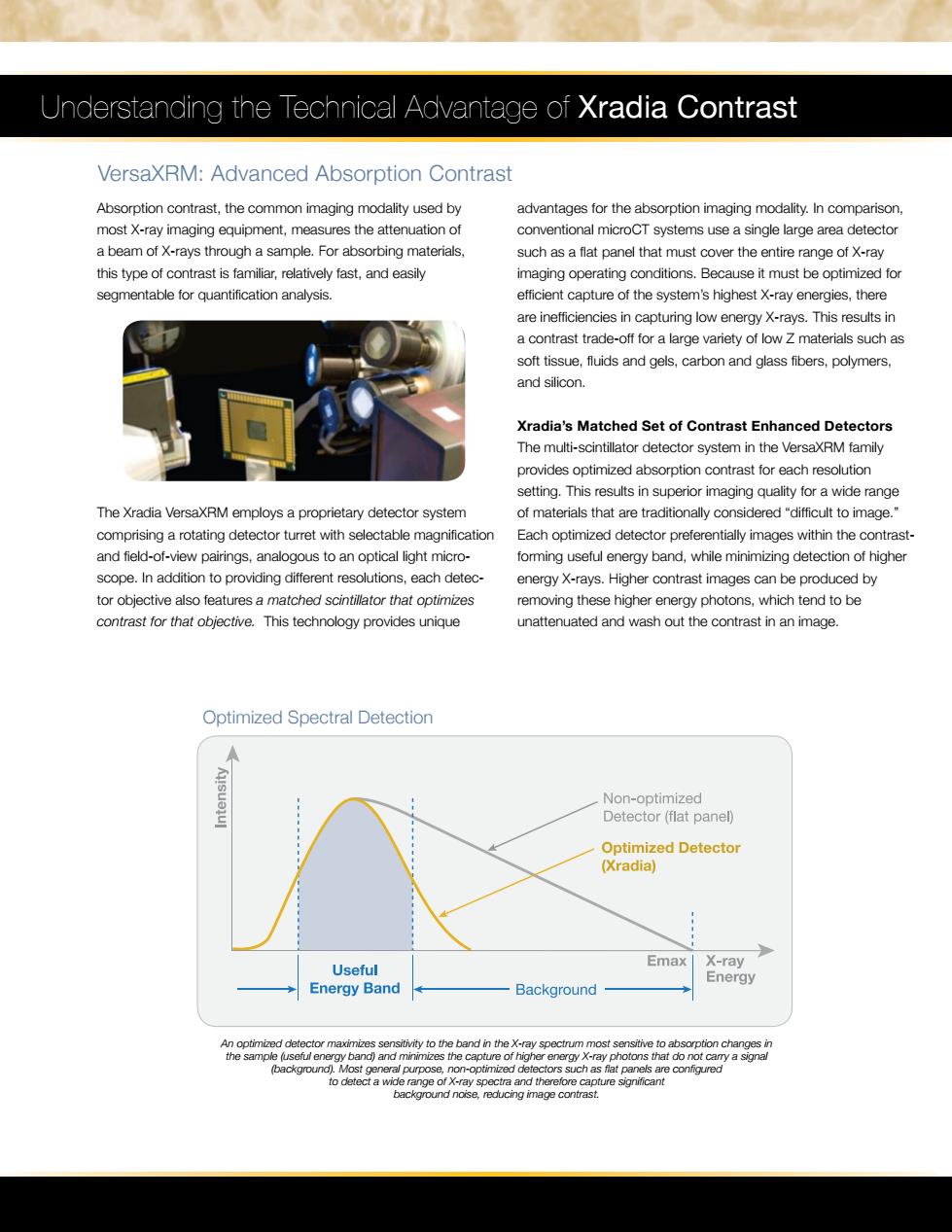正在加载图片...

Understanding the Technical Advantage of Xradia Contrast VersaXRM:Advanced Absorption Contrast Absorption contrast,the common imaging modality used by advantages for the absorption imaging modality.In comparison, most X-ray imaging equipment,measures the attenuation of conventional microCT systems use a single large area detector a beam of X-rays through a sample.For absorbing materials, such as a flat panel that must cover the entire range of X-ray this type of contrast is familiar,relatively fast,and easily imaging operating conditions.Because it must be optimized for segmentable for quantification analysis. efficient capture of the system's highest X-ray energies,there are inefficiencies in capturing low energy X-rays.This results in a contrast trade-off for a large variety of low Z materials such as soft tissue,fluids and gels,carbon and glass fibers,polymers. and silicon. Xradia's Matched Set of Contrast Enhanced Detectors The multi-scintillator detector system in the VersaXRM family provides optimized absorption contrast for each resolution setting.This results in superior imaging quality for a wide range The Xradia VersaXRM employs a proprietary detector system of materials that are traditionally considered"difficult to image." comprising a rotating detector turret with selectable magnification Each optimized detector preferentially images within the contrast- and field-of-view pairings,analogous to an optical light micro- forming useful energy band,while minimizing detection of higher scope.In addition to providing different resolutions,each detec- energy X-rays.Higher contrast images can be produced by tor objective also features a matched scintillator that optimizes removing these higher energy photons,which tend to be contrast for that objective.This technology provides unique unattenuated and wash out the contrast in an image. Optimized Spectral Detection Non-optimized Detector(flat panel) Optimized Detector (Xradia) Useful Emax X-ray Energy Energy Band Background An optimized detector maximizes sensitivity to the band in the X-ray spectrum most sensitive to absorption changes in the sample (useful energy band)and minimizes the capture of higher energy X-ray photons that do not cary a signal (background).Most general purpose,non-optimized detectors such as flat panels are configured to detect a wide range of X-ray spectra and therefore capture significant background noise,reducing image contrast.Absorption contrast, the common imaging modality used by most X-ray imaging equipment, measures the attenuation of a beam of X-rays through a sample. For absorbing materials, this type of contrast is familiar, relatively fast, and easily segmentable for quantification analysis. The Xradia VersaXRM employs a proprietary detector system comprising a rotating detector turret with selectable magnification and field-of-view pairings, analogous to an optical light microscope. In addition to providing different resolutions, each detector objective also features a matched scintillator that optimizes contrast for that objective. This technology provides unique advantages for the absorption imaging modality. In comparison, conventional microCT systems use a single large area detector such as a flat panel that must cover the entire range of X-ray imaging operating conditions. Because it must be optimized for efficient capture of the system’s highest X-ray energies, there are inefficiencies in capturing low energy X-rays. This results in a contrast trade-off for a large variety of low Z materials such as soft tissue, fluids and gels, carbon and glass fibers, polymers, and silicon. Xradia’s Matched Set of Contrast Enhanced Detectors The multi-scintillator detector system in the VersaXRM family provides optimized absorption contrast for each resolution setting. This results in superior imaging quality for a wide range of materials that are traditionally considered “difficult to image.” Each optimized detector preferentially images within the contrastforming useful energy band, while minimizing detection of higher energy X-rays. Higher contrast images can be produced by removing these higher energy photons, which tend to be unattenuated and wash out the contrast in an image. Understanding the Technical Advantage of Xradia Contrast An optimized detector maximizes sensitivity to the band in the X-ray spectrum most sensitive to absorption changes in the sample (useful energy band) and minimizes the capture of higher energy X-ray photons that do not carry a signal (background). Most general purpose, non-optimized detectors such as flat panels are configured to detect a wide range of X-ray spectra and therefore capture significant background noise, reducing image contrast. 1 Optimized Spectral Detection VersaXRM: Advanced Absorption Contrast